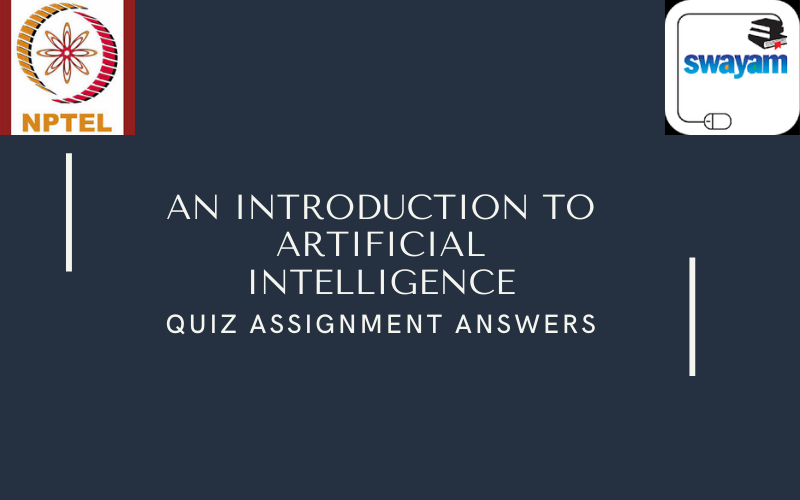An Introduction To Artificial Intelligence The course aims to cause an enhanced awareness about the significance of soft skills in professional and inter-personal communications and facilitate an all-round development of personality. Hard or technical skills help securing a basic position in one’s life and career. But only soft skills can ensure a person retain it, climb further, reach a pinnacle, achieve excellence, and derive fulfilment and supreme joy. Soft skills comprise pleasant and appealing personality traits as self-confidence, positive attitude, emotional intelligence, social grace, flexibility, friendliness and effective communication skills.
An Introduction To Artificial Intelligenceis a MOOC based course that is 12 weeks in duration and can fulfill the criteria of 4 credits in a year. You can visit the NPTEL SWAYAM platform and register yourself for the course. This course is brought to you by Prof. Mausam Mausam is an Associate Professor of Computer Science department at IIT Delhi, and an affiliate faculty member at University of Washington, Seattle.
INDUSTRY SUPPORT: All industries
CRITERIA TO GET A CERTIFICATE
Average assignment score = 25% of the average of the best 8 assignments out of the total 12 assignments given in the course.
Exam score = 75% of the proctored certification exam score out of 100
Final score = Average assignment score + Exam score
Students will be eligible for CERTIFICATE ONLY IF AVERAGE ASSIGNMENT SCORE >=10/25 AND EXAM SCORE >= 30/75.
An Introduction To Artificial Intelligence Assignment Week 8 Answers:-
Contents
Q1. You measure the temperature of the water in a swimming pool using a special thermometer, having range 15 degree celsius to 25 degree celsius, with a least count of 0.5 degree celsius. You take measurements on each day, which can be seen as a random variable in which of the following probability spaces ?
Answer:- C – Continuous
Q2. Suppose you have the following three variables with given possible values –
Weather: Sunny, Rainy, Cloudy, Snowy
Temperature: Low, Medium, High
Humidity: 1,2,3,4,5
What is the size of the joint probability distribution matrix for the above ?
Answer:- 60
Q3. You want to calculate P(x=6|y=1) in fractional form in lowest form (such that the numerator and denominator are co-prime). What is the value of the denominator ?
Answer:- 4
Q4. You are working on your laptop, and you hear a whirring noise from it, whenever you boot it. SoYou go to a technician and he tells you that 80% of the cases of laptop repair that come to him, have the same problem of whirring noise. You assume that the issue is from your hard-drive, and you read online that 20% of all laptop issues are hard-drive related, while the problem of getting a whirring noise from the laptop on boot from a hard-drive related issue is 50%. Given this information, you calculate the probability that you have a hard-drive related issue in your laptop, in the simplest fractional form (numerator and denominator are co-prime). What is the denominator ?
Answer:- 10
IF THERE IS ANY CHANGE IN ANSWERS WILL UPDATE ON OUR TELEGRAM GROUP BY 11:30 PM SO KINDLY JOINS US THERE.
Q5. Which of the following statements are true with respect to Bayesian Networks syntax taught in class ?
Answer:- B,D
Q6. How many parameters are required to specify the following Bayesian Network assuming each variable is binary?
Answer:- 12
Q7. In the network below which of the following pairs of variables are conditionally independent given evidence about C?
Answer:- C – B and E
Q8. In the previous graph which variable(s) are in the Markov Blanket of C?
Answer:- A,B,D,E
Q9. In the Bayesian Network given below, what is the probability that Mary calls given that an Earthquake has occurred? Write the solution after rounding off to first 3 decimal digits
Answer:- 0.986
Q10. Which of the following statement(s) is(are) true?
Answer:- A,B,C,D
Q11. Consider the following Bayesian Network with the given information. What is the value of P(a | d, e) up to 3 decimal places?
Answer:- 0.284
An Introduction To Artificial Intelligence Assignment Week 7 Answers:-
Q1. Which of the following are examples of fuzzy logic?
Answer:- B,D
Q2. We are given a randomized algorithm A which tries to prove Boolean statements. But, A fails with a small probability of 0.01% i.e. it will say that a true statement is false or vice versa with this probability. This algorithm is
Answer:- A
Q3. Consider the following S1 : (a -> b), S2: (¬a v b). Which of the following is(are) always true?
Answer:- A,B,C,D
Q4. Which of the following statement(s) is(are) true about forward chaining?
Answer:- A,D
Q5. Which of the following components of Knowledge Representation encodes the grammar that represents all sentences in the language?
Answer:- C- Syntax
JOIN US ON TELEGRAM
Q6. Suppose a crime happens, and you have three suspects, A, B and C.
A says “B is innocent but C is guilty”
B says “I am innocent but atleast one of the other two is guilty”
C says “If A is guilty then so is B”
Assume that innocents speak the truth and the guilty always lie. You have the following three propositions now-
Which of the following propositions can be proved by resolving with the ones obtained from the above dialogue given ?
Answer:- D,E
Q7. Which of the following can be reduced to a single satisfiability problem ?
Answer:- A,C
Q8. Suppose you have the following SAT problem in the form of clauses –
{ {a ¬b c} {¬b c} {¬c d ¬e} {¬c} {¬a ¬b e} {a ¬b e} {d b} {e a ¬c} }
You simplify the above given SAT problem, by repetitively removing only unit literals and pure literals, like say, you removed a pure literal, and on simplification, you again check for presence of pure literals, and so on, till no unit literals or pure literals are left. What is the final reduced problem ?
Answer:- C
Q9. For the following SAT problem, you are running the DPLL algorithm, with MOM’s heuristic. What is the variable you will branch on next (Do not consider resolving pure or unit literals) ? { {a ¬b c} {¬b c} {¬c d ¬e} {¬a ¬b e} {a ¬b e} {d b} {e a ¬c} }
Answer:- B
Q10. Which of the following are true ?
Answer:- B,C
An Introduction To Artificial Intelligence Assignment Week 6 Answers:-
Q1. What is the number of edges in a constraint graph for Sudoku given that only binary constraints used? Assume that the constraints are of the form a != b or a = b where a, b are variables (one per cell of the Sudoku) . Assume that the domain of variables is integers from 1 to 9. For example, one constraint would be x11 != x12 where xij is the variable corresponding to the (i, j)th cell.
Answer:- 7
Q2. Which of the following are valid heuristics to decide which variable to assign next in a backtracking search for solving CSPs ?
Answer:- a) Min Conflicts heuristic b) Minimum Remaining Values heuristic c) Degree heuristic d) Least Constraining Value heuristic
Q3. Suppose you have the following constraint graph and you need to find an assignment for each of the variables so that constraint satisfaction problem can be solved. A wise man comes along to help you and offers to tell you the value of any one of the variables. Which of the following variables (enter exact case sensitive string) will you choose so that your search procedure simplifies the most?
Answer:- T
Q4. You are given a CSP with n variables and each variable can take d values. You are able to decompose this problem into two independent subproblems each having n/2 variables. One of those subproblems is found to have a cutset of size c (c < n/2), such that resolving these results rest of the remaining variables to only form a tree. What are the valid expressions for the worst-case time complexity of solving this CSP using the information of decomposition?
Answer:- a) O(dn)
b) O(dc.(n/2 - c).d2)
c) O(dn/2 + dc.(n/2 - c).d2)
d) O(dn/2.dc.(n/2 - c).d2)
Q5. Which of the following statement(s) is/are true for CSPs?
Answer:- a) Tree structured CSPs can be solved in polynomial time.
b) Iterative min-conflicts algorithm can solve the n-queens problem with n values upto 1000 and even higher in constant time in practice.
c) Forward consistency checks can propagate information between two unassigned variables.
d) After performing arc consistency we can solve any CSP without requiring any backtracking.
JOIN US ON TELEGRAM
Q6. Which of the following choices are relevant for significantly speeding up backtracking search?
Answer:- a) Which variable needs to be assigned in a state b) The order of values to be tried at each step c) The efficiency of the priority queue implementation d) Ways of detecting failure early based on the current state
Q7. According to the MRV heuristic with degree tie-breaking which variable (state of the country) is assigned in the next step of the below chain
Answer:- a) Western Australia
b) New South Wales
c) Victoria
d) Tasmania
e) There is a tie.
Q8. In the map below suppose we decide to assign colour to Victoria next. According to the least constraining value heuristic, which value gets assigned?
Answer:- a) Red
b) Blue
c) Green
d) There is a tie.
Q9. You also perform Forward Checking while doing this, and you terminate the algorithm accordingly, if needed (Note that you are not doing any backtracking here). What is the value of the counter when the algorithm terminates ?
Answer:- 1
Q10. Now in addition to Forward Checking, Arc Consistency checks are also used. What is the value of the counter when the algorithm terminates ?
Answer:- 0

Also Check:- NPTEL » Art of C Programming Quiz Assigment Week 1 2021
- NPTEL » Problem solving Programming In C Assignment 2021
- NPTEL » Introduction to Machine Learning Assignment 1 2021
[foobar id=”1315″]


